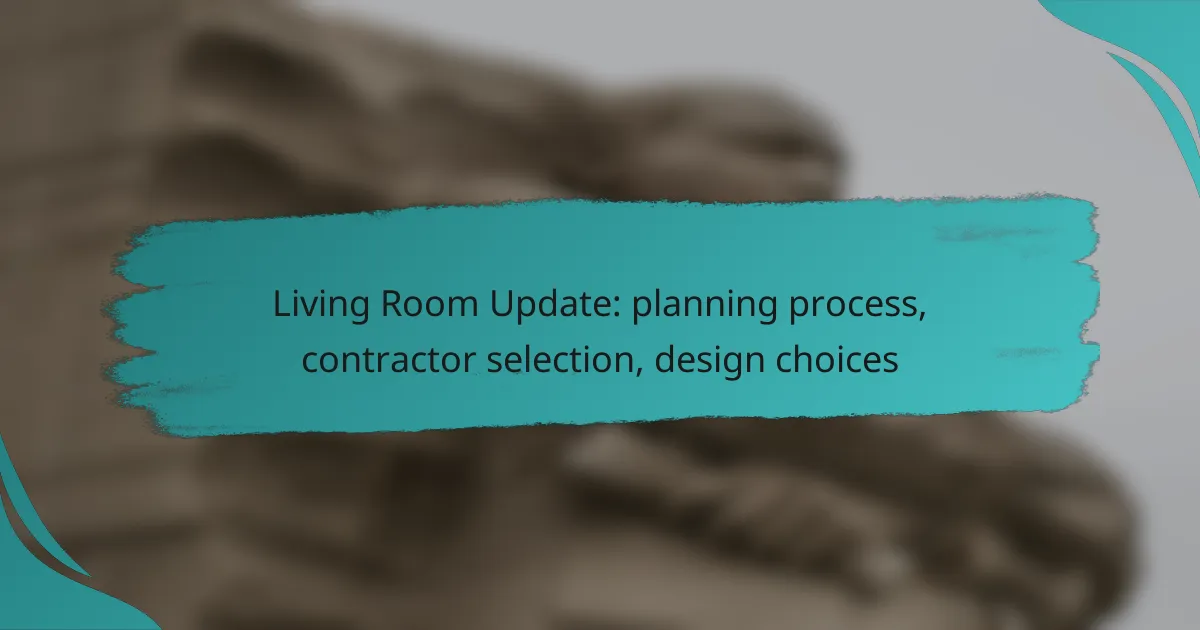Updating your living room is an exciting opportunity to enhance both its functionality and aesthetic appeal. The process begins with careful planning, including budgeting and timeline setting, followed by selecting a qualified contractor who aligns with your vision. Thoughtful design choices, from color palettes to furniture styles, play a crucial role in creating a space that reflects your personal style while meeting your needs.

What are the key steps in planning a living room update in Canada?
Planning a living room update in Canada involves several essential steps, including budgeting, setting a timeline, and defining your style preferences. These steps ensure a smooth renovation process and help you achieve your desired outcome while staying within your means.
Define your budget
Establishing a budget is crucial for a successful living room update. Determine how much you can afford to spend, considering both materials and labor costs. In Canada, living room renovations can range from a few thousand to tens of thousands of Canadian dollars, depending on the scope of work.
Be sure to include a contingency fund of about 10-20% for unexpected expenses. This will help you avoid financial strain during the renovation process.
Set a timeline
Setting a realistic timeline for your living room update helps manage expectations and keeps the project on track. Consider how long each phase will take, from planning and design to construction and finishing touches.
A typical living room renovation might take anywhere from a few weeks to several months, depending on the complexity of the project and the availability of contractors. Make sure to account for potential delays, such as supply chain issues or contractor scheduling conflicts.
Identify your style preferences
Understanding your style preferences is essential for creating a cohesive living room design. Consider what aesthetic appeals to you, whether it’s modern, traditional, minimalist, or eclectic.
Gather examples of designs you like, which will help guide your choices in colors, materials, and furnishings. This clarity will make it easier to communicate your vision to contractors and designers.
Gather inspiration
Collecting inspiration can spark creativity and help you visualize your updated living room. Use platforms like Pinterest, Instagram, or home design magazines to find images that resonate with your style preferences.
Create a mood board to compile your favorite ideas, colors, and layouts. This visual reference will serve as a helpful guide throughout the renovation process.
Consider functional needs
When updating your living room, it’s important to assess your functional needs. Think about how you use the space and what improvements could enhance its usability, such as better lighting, additional seating, or improved storage solutions.
For example, if you frequently entertain guests, consider an open layout or a larger seating arrangement. If you have children or pets, durable materials and easy-to-clean surfaces may be a priority.

How to select the right contractor for a living room update?
Selecting the right contractor for a living room update involves evaluating their qualifications, experience, and past work. A well-chosen contractor can ensure that your project runs smoothly and meets your expectations.
Check credentials and licenses
Start by verifying that potential contractors hold the necessary licenses and certifications required in your area. This may include general contractor licenses, insurance, and bonding, which protect you from liability during the project.
In the U.S., for example, many states require contractors to pass exams and maintain certain insurance levels. Always request proof of these credentials before proceeding.
Read reviews and testimonials
Look for reviews and testimonials from previous clients to gauge the contractor’s reputation. Websites like Yelp, Angie’s List, or local home improvement forums can provide insights into their reliability and quality of work.
Pay attention to recurring themes in the feedback, such as punctuality, communication, and craftsmanship, as these can indicate the contractor’s strengths and weaknesses.
Request detailed quotes
When you narrow down your options, ask for detailed quotes from each contractor. A comprehensive quote should outline labor costs, materials, timelines, and any potential additional expenses.
Comparing these quotes can help you identify which contractor offers the best value for your living room update. Be cautious of quotes that seem significantly lower than others, as they may indicate hidden costs or subpar materials.
Interview potential contractors
Conduct interviews with your top choices to discuss your vision and assess their expertise. Prepare a list of questions regarding their experience with similar projects, timelines, and how they handle challenges that may arise.
This interaction can also help you gauge their communication style and whether you feel comfortable working with them throughout the project. Trust your instincts; a good rapport can make a significant difference in the project’s success.

What design choices should you consider for your living room?
When updating your living room, consider design choices that enhance functionality and aesthetics. Key elements include color palettes, furniture styles, lighting options, and flooring materials, all of which contribute to the overall atmosphere and usability of the space.
Choose a color palette
Selecting a color palette is essential for setting the mood in your living room. Aim for a cohesive scheme that reflects your personal style while considering the room’s size and natural light. Neutral tones can create a spacious feel, while bold colors can add energy and warmth.
Consider using a combination of three to five colors, including a dominant shade, a secondary color, and accent hues. Tools like color wheels or online design apps can help visualize how different colors work together.
Select furniture styles
Your choice of furniture styles should align with the overall design theme of your living room. Popular styles include modern, traditional, and eclectic, each offering a unique aesthetic. Assess your needs for comfort and functionality alongside visual appeal.
When selecting furniture, consider scale and proportion to ensure pieces fit well within the space. For example, a large sectional sofa may dominate a small room, while a sleek loveseat might provide a better balance.
Incorporate lighting options
Lighting plays a crucial role in enhancing the ambiance of your living room. A mix of ambient, task, and accent lighting can create a layered effect that adds depth and warmth. Consider overhead fixtures, floor lamps, and table lamps to achieve this balance.
When choosing lighting, think about the activities that will take place in the room. For reading or entertaining, adjustable lighting options can provide flexibility. Aim for a combination of warm and cool light sources to cater to different moods.
Plan for flooring materials
The flooring you choose can significantly impact the look and feel of your living room. Options range from hardwood and laminate to carpets and tiles, each offering distinct advantages. Consider durability, maintenance, and comfort underfoot when making your selection.
For example, hardwood floors can provide a timeless appeal and are easy to clean, while carpets offer warmth and sound absorption. If you have pets or children, choose materials that can withstand wear and tear while still looking stylish.

What are the common mistakes to avoid during a living room update?
Common mistakes during a living room update include overlooking functionality, ignoring budget constraints, and rushing the decision-making process. Avoiding these pitfalls can lead to a more successful and satisfying renovation experience.
Overlooking functionality
Functionality is crucial in a living room update. Consider how the space will be used daily; prioritize layouts that facilitate movement and comfort. For example, ensure seating arrangements allow for conversation and easy access to entertainment options.
Incorporate storage solutions that blend seamlessly with the design, such as built-in shelves or multi-functional furniture. This approach not only enhances usability but also keeps the space organized and visually appealing.
Ignoring budget constraints
Establishing a realistic budget is essential for any living room update. Determine a range that includes all costs, such as materials, labor, and unexpected expenses, typically adding an extra 10-20% for contingencies. This helps prevent overspending and financial stress.
Research costs for materials and labor in your area, and prioritize spending on elements that will have the most significant impact, like flooring or furniture. Avoid the temptation to splurge on trendy items that may not provide long-term value.
Rushing the decision-making process
Taking time to make informed decisions is vital in a living room update. Rushing can lead to choices that don’t align with your vision or needs. Spend adequate time researching design options, materials, and contractors to ensure you are making the best selections.
Consider creating mood boards or visiting showrooms to visualize your ideas before committing. This preparation can help you avoid costly mistakes and ensure that the final design reflects your style and functionality requirements.

How to create a cohesive design plan for your living room?
Creating a cohesive design plan for your living room involves defining a clear vision that integrates color, style, and functionality. Start by identifying your design goals and preferences, which will guide your choices throughout the renovation process.
Develop a mood board
A mood board is a visual tool that helps you consolidate your design ideas and inspirations for your living room. It typically includes images, color swatches, fabric samples, and other elements that reflect your desired aesthetic.
To create an effective mood board, gather materials from magazines, online platforms, or design apps. Aim for a balanced mix of textures and colors that resonate with your vision. This will serve as a reference point during the planning and execution stages.
Consider using digital tools like Pinterest or Canva for easy organization and sharing. A well-crafted mood board not only clarifies your design intent but also aids in communicating your ideas to contractors and designers.
